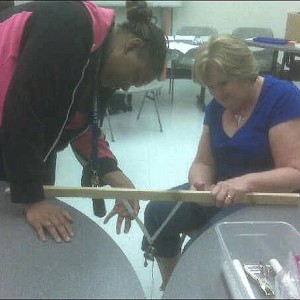Middle school teachers Jimmie Gilbert and Cheryl Anderson inquire into the physics of forces at a workshop. This activity was a revelation to me the first time I tried it. OMG, it’s a way to visualize force vectors. Although direction only. The magnitude is actually represented by the thickness or thinness of the paper that is required to hold up the weight. I got this from Learner.org. It wasn’t specifically an “activity” to do with students. The teachers worked together to turn it into something for middle schoolers to learn from. I already posted this to the blog, years ago. Linked here.
Now this has something to do with Common Core implementation, but it’s kind of a complex argument, as are all my arguments, because the issues of schooling are way embedded in the culture and difficult to tease out.
The impetus for writing about Common Core is a conversation I had last Friday with a 17-year-old honors student, Brandon. What do you think about Common Core? he asked me. This is the sort of question I get from a lot of people. I invited him to explain a little more what he meant by CC. Well, in English we get these packets and we have to do the packet and then write an essay. And that’s good because I need to improve my ability to communicate. But in physics, we just get together in groups and try to work out problems. Maybe the teacher will do one or two of them. And our classes are short. We only have 48 minutes. And by the time you get into class and settle down, and then work for half an hour, then it’s time to pack up.
I can’t see that working very well, I responded. CC is supposed to be about doing fewer topics in greater depth. And you’re supposed to be asking questions, collecting evidence, analyzing it and then making claims. That doesn’t sound like what you’re doing. (Actually Brandon was probably talking about NGSS, which has gotten conflated with Common Core. Another unfortunate bit of misinformation.)
And then there is the issue that physics is the science of what underlies the obvious. Physics is definitely NOT obvious. Otherwise it wouldn’t have taken brilliant minds like Aristotle and Galileo and Newton and Einstein and Richard Feynman, to name the most famous, 2000 years to figure out how the common, everyday things like throwing a ball happen. How come the teacher understands this way of teaching as consistent with NGSS? Probably he attended professional development and was given the activity to do with his students. So he grits his teeth and does what he is told. So very many teachers are cynical and just waiting for retirement. And completely confused by reforms, because understanding the reforms means adopting a completely different socially-constructed identity about what it means to be a teacher. This is something I’ve written about, seemingly to deaf ears, for the last 20 years. Click to see an example: Link.
I hope to continue this post tomorrow. G2g

